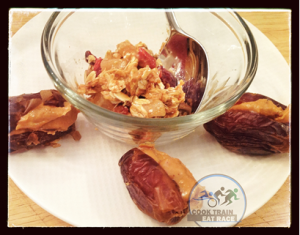Jason from Cook Train Eat Race is back with some super snack info! And I can’t wait to try these – I’d actually though about stuffing dates with nut butter as a snack myself…so read on!
Ask any endurance athlete what a typical day of eating is like and they will rattle of the three meals and then rave on about their snacks in between meals because you should eat more often (although smaller portions) and their hunger is uncontrollable with the amount of training they do.
Ask them what they snack on and the typical response of a protein bar is likely not very far behind. Bars have their place in an endurance athlete’s diet but for me I would rather snack on whole foods. Foods, or snacks, that I make in my kitchen and that allow me to know what every ingredient going into my mouth is and what its purpose is.
I believe that we should eat with a purpose and that purpose is to either fuel us for an upcoming workout or re-fuel us after a workout. Most endurance athletes are keen about the benefits of a recovery meal but it seems they tend to lose focus when it comes to their snacks and are eating what would amount to a full meal instead of something to hold them over.
When I make a snack, and typically no week has the same snack in it, I make sure that it lies somewhere between 300 and 400 calories and provides me plenty of fiber. Why fiber? Fiber is important because it gives us the sensation of being full and allows us to stave off hunger pains until we are ready to eat a bigger meal, or have the time to eat a bigger meal. According to the Institute of Medicine it is recommended that we consume 14g of fiber for every 1,000 calories of food we eat. This number will change based on the age of a person from what I read but this is fairly average.
This week I am in the middle of my overload weeks for Ironman Texas. This means that I am training nearly 21 hours per week and as you can suspect means lots of fueling and refueling and being hungry. As I was planning out my meals and snacks for the week I looked to see what my training was as well as what I had in my pantry to ensure that I was going to get adequate calories and have the food be tasty as well. As I created the plan I made sure that the following two snacks were included. Homemade Raw Granola with Nut Butter Stuffed Dates and Honey-Ginger Roasted Vegetables With Falafel Hummus.
These sound like pretty hefty snacks don’t they? They aren’t and both are within (well really close) the 300 – 400 calorie marker for snacks and are high in fiber as well as having carbohydrates and protein. Here are the nutrition facts with portion sizes for both snacks:
Raw Granola With Nut Butter Stuffed Dates:

|
Ingredient |
Calories |
Carbs |
Fat |
Protein |
Fiber |
| Dates – 3 |
199 |
54 |
0 |
1 |
5 |
| Peanut Butter – 1 Tbsp |
105 |
3 |
8 |
4 |
1 |
| Old Fashioned Rolled Oats – 2 Tbsp |
24 |
4 |
0 |
1 |
1 |
| Honey – 0.5 Tbsp |
32 |
9 |
0 |
0 |
0 |
| Dried Pineapple – 1 Tsp |
12 |
3 |
0 |
0 |
1 |
| Goji Berries – 1 Tsp |
3 |
1 |
0 |
0 |
0 |
| Dried Cranberries – 1 Tbsp |
12 |
3 |
0 |
0 |
0 |
| Totals |
377 |
77 |
8 |
6 |
8 |
I used my own homemade nut butter for this recipe but since you won’t have my nut butter in your house I put in a typical jar of peanut butter that can be found at any local grocery store.
Honey-Ginger Roasted Vegetables With Falafel Hummus:

|
Ingredient |
Calories |
Carbs |
Fat |
Protein |
Fiber |
| Honey – 2 Tbps |
128 |
35 |
0 |
0 |
0 |
| Garbanzo Beans – 130g |
110 |
20 |
2 |
5 |
6 |
| Carrots – 260g |
107 |
25 |
1 |
2 |
7 |
| Brussels Sprouts – 132g |
48 |
9 |
0 |
4 |
4 |
| Peppers – Green Bell Pepper-Raw, 60 g |
19 |
4 |
0 |
1 |
1 |
| Totals |
412 |
93 |
3 |
12 |
18 |
To make the falafel hummus use the juice of 1/2 lemon along with a bunch of cilantro, parsley, some water and 2 garlic cloves. If you don’t want it to be green just skip the parsley and cilantro and keep the rest. Sometime when I make hummus I will drop in a little bit of hot sauce and 1 Tsp of peanut butter to add spice and thicken.
As you can see from the totals there is right around 400 calories and plenty of fiber in these snacks as well as quality complex carbohydrates and protein while the fats are healthy fats.
This combination will keep you feeling full as well as satisfied. Now the question of portability comes into play and these snacks are very portable in a tupperware. If you work in an office you can re-heat the glazed vegetables while the other portions of the snacks do not need to be reheated and the vegetables are fine cold as well.
What do you typically snack on?




